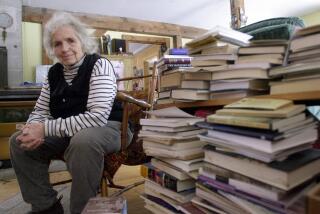Lecture Becomes Lesson on Hurdles to Overcome
- Share via
A lecture at the First African Methodist Episcopal Church on Thursday was aimed at showing that Jews and blacks have in common a shared heritage of persecution: scholars presented newly uncovered evidence that it was during the German colonization of Africa that Nazis developed some of the racist ideology they later applied to Jews.
The scholars detailed for the mixed audience how the Nazis tortured and murdered African American prisoners of war because of their race, and how they sterilized young children of mixed African and German blood to maintain what they claimed was “racial purity.”
Then the floor was opened to questions, and a 16-year-old African American girl clutching a notebook asked: “Why is there so much tension between blacks and Jews?”
After a painful silence, a white-haired African American woman told the girl she would get no answers at the forum because the Jews present were the source of the problem. She told the girl she should study the writings of Louis Farrakhan and Khallid Abdul Muhammad to get the real answers.
A Jewish member of the audience responded by criticizing Farrakhan for allegedly associating with white racists and having a “divide and conquer” strategy.
Then, another member of the audience said the content of the lecture showed a reason for Jews and blacks to come together: “We survivors are like a family--if we can demonstrate we suffered the same genocide, that should make us brothers!”
The moderator of the event, organized by the Martyrs Memorial and Museum of the Holocaust, tried to steer questions back to the official topic: how the newly uncovered history of black victimization by the Nazis might be introduced in secondary school classrooms. But he could not stop the subsequent free-for-all, as the Farrakhan believers and Jewish audience members followed the girl outside and alternately tugged at her arm, with many saying, “Don’t listen to them! “
Surrounded by her shouting elders, the girl had tears in her eyes but maintained her composure and continued to try to find an answer. “I heard,” she said, “that blacks and Jews once worked together in the civil rights movement. What happened?”
Finally, the Rev. Leonard Jackson, associate minister of the predominantly black church, took her to a quiet room. He said the answer that he gave her was that blacks and Jews have been divided by people afraid of the power they would have if they were united.
“We need to look at this as a blessing,” Jackson said of the disagreement that erupted. “It should erase the doubt in everyone’s mind that (education) is needed.”
Indeed, the lecture had been inspired by another fracas--the controversy that erupted after some Oakland high school students were kicked out of a movie theater for laughing at scenes of the murder of Jews in the movie “Schindler’s List.”
Alex Grobman, director of the Holocaust museum, who moderated Thursday’s event, said that the Oakland students reacted that way because they were unfamiliar with history and did not understand that the events in the film really happened. He invited several of the students to visit the museum, and found that they were genuinely interested in understanding what had happened under the Nazis.
Sam Goetz, chairman of the museum and a survivor of the camp featured in the film, said the students became “very emotional” as they heard his story firsthand.
Grobman and Goetz concluded that they had to find a way to teach the Holocaust that makes sense to diverse students. They looked for Holocaust stories that involved blacks, and discovered the work of Howard University-trained academics Susanne Riveles and Robert Kesting, who were the featured speakers Thursday.
Kesting, an archivist at the U.S. Holocaust Memorial Museum in Washington, said that in one case, 11 captured African American soldiers were humiliated by Nazi SS officers and forced to carry them on their backs before they were tortured, mutilated and executed. Other black soldiers were forced to dig their own graves before they were executed.
Although white soldiers were also mistreated by Germans, Kesting says blacks tended to be treated worse because of their race.
In a horrific example of Nazi eugenics--the pseudo-science of genetically “improving” the human race--hundreds of half-black, half-German children, ages 6 to 12, were sterilized under government dictates in the 1930s, Kesting said. Some may have been killed in Nazi “euthanasia” programs, he said.
Labeled the “Rhineland bastards,” the children were for the most part the offspring of German women who married African soldiers who were part of the French army occupying western Germany after World War I.
Riveles detailed how the racist attitudes of some Nazi officials were shaped by their experiences in German colonies in Africa, where they began to consider some races subhuman.
The stories of the shared history of suffering under the Nazis were deeply moving, said several members of the audience, which was largely made up of schoolteachers of various races. But the controversy surrounding the teen-ager’s question clearly shook up many people.
Cookie Lommel, founder of a group called Operation Unity, which is aimed at improving black-Jewish relations, compared the tension between the African Americans and Jews to “sibling rivalry--you do so many things together but you also fight.”
She shook her head at the fracas caused by the girl’s innocent question. “It shows what a hot button it is,” she said.
More to Read
Sign up for Essential California
The most important California stories and recommendations in your inbox every morning.
You may occasionally receive promotional content from the Los Angeles Times.













